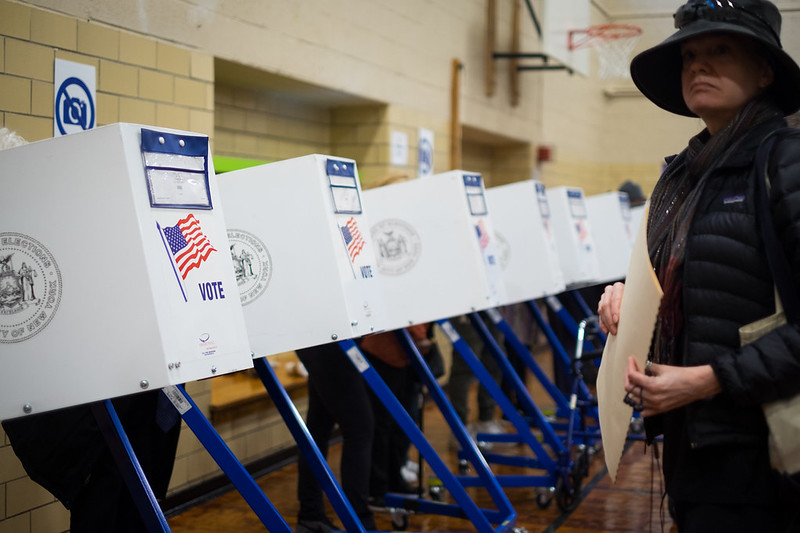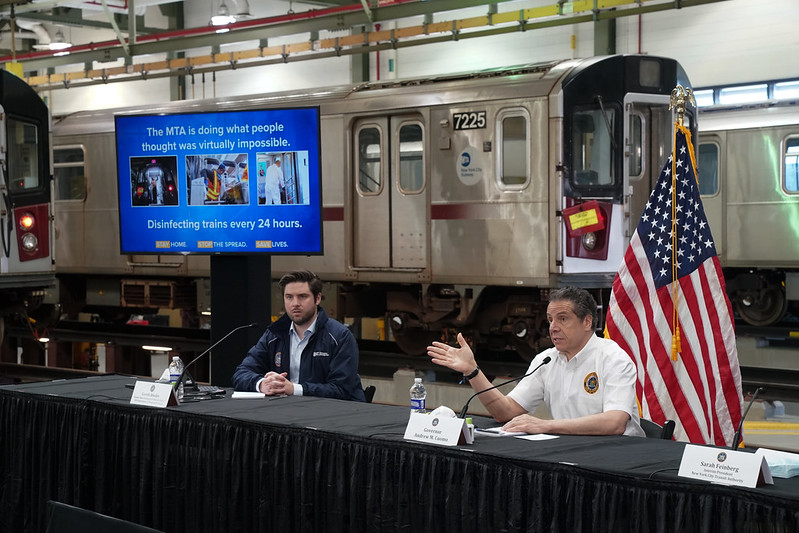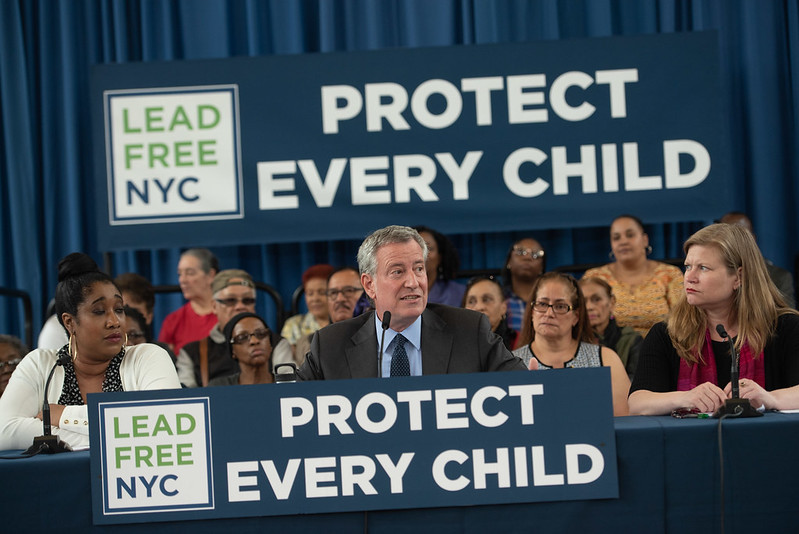The Unexpected Way to Make Your Vote Actually Matter in New York This Presidential Election

Voting this fall is set to commence soon (photo: Edwin J. Torres/Mayoral Photo Office)
There’s one simple reason why New Yorkers should vote for the Libertarian ticket for President this year: it’s the most effective, real, and tangible way to support democracy.
Earlier this year, Governor Cuomo and the Legislature unfairly raised the barriers for third parties to appear on the ballot in New York State. Your vote for Dr. Jo Jorgensen, the Libertarian candidate for President, can help thwart Cuomo’s goal of depriving New Yorkers of any real choice beyond “the Democrat” and “the Republican.”
This is important. Here’s why.
First, we must recognize that New Yorkers’ presidential votes do not matter in 2020. This is not an insult. Joe Biden is favored to win the state 99 to 1 and the latest poll has Biden up 31 percent on President Trump. Under our electoral college system, New York’s 29 electoral votes will all go to Joe Biden. The ultimate number of individual votes Biden and Trump receive makes no practical difference.
Second, in April of this year, at the height of the COVID-19 pandemic, Cuomo inserted into the state budget a law to effectively kill third parties. The law increases the number of votes and signatures it takes to get onto the ballot and to stay on, securing a ballot line on which to nominate candidates. In New York, unlike in other states, a political party has only one route to get onto a state-wide ballot: it must gather enough valid voter signatures over six weeks to petition its candidate onto the ballot on its party line. Once on the ballot, if the party’s gubernatorial candidate garners enough votes, the party gets to avoid petitioning and operate as normal—so long as its gubernatorial candidates keep garnering enough votes every four years.
Until April, this meant 15,000 signatures and 50,000 votes for governor. The new law makes three changes that render this already difficult process much more onerous: First, it triples the number of signatures to 45,000. Second, it raises the number of votes to 2% of the total vote or 130,000, whichever is greater. (Recent presidential elections show that 2% is around 160,000.) Third, it applies these new thresholds every two years to presidential and gubernatorial elections, not just every four years to gubernatorial elections as in the past.
This new law is not fair. The commission that first conceived these changes in 2019 before its recommendations were struck down as unconstitutional claimed that the increase was to account for population growth since the 1930s, but that would result in only a 1.27% vote threshold or about 100,000 votes.
In reality, nothing explains the vote threshold the commission came up with, the tripling of signatures for petitioning without any extension of time for collection, or doubling the frequency for qualification—except as an attempt to save the Democratic and Republican Parties the inconvenience of having third parties in the general election. Third parties (except for the Conservative Party, which only cross-endorses certain Republicans) don’t generally meet this new threshold, and the new, nearly impossible petitioning threshold will keep them off the ballot or bury them in busywork to neuter their effectiveness.
No believer in democracy and voter choice should support this law. Most of the third parties in New York have sued to stop it, despite our limited resources, though it’s not looking good.
But you can save us! If you are willing to part with your symbolic vote for Biden or Trump and cast it instead for Dr. Jo Jorgensen, you can make a real difference and save ballot access for the country’s third-largest party, the Libertarian Party. Getting to 160,000 votes is not impossible, but it will require a lot of help from non-Libertarians who agree that the ballot should not be used as a cynical tool to eliminate inconvenience and who appreciate the democratic ideal that voters should have real, diverse choices available to them.
Unlike other third parties in New York who use the “fusion” system to primarily cross-endorse major party candidates, we in the Libertarian Party volunteer our time, energy, and funds as a public service to present our own unique candidates. After more than 40 years of trying to simply overcome the obstacles to the ballot, we finally attained automatic ballot access in 2018 with Larry Sharpe’s gubernatorial run, which also expanded the political discussion in important ways.
Since then, we’ve been able to gain momentum to elect Libertarians, including a district attorney in Broome County (Binghamton). Here in New York City, we are currently running five congressional candidates, including Michael Madrid’s spirited opposition to Rep. Jerry Nadler, and are gearing up for 2021. Our candidate for Public Advocate last year presented not only the sole minor party voice, but also one with vision and passion for local reform that transcended partisan ideology.
We Libertarians present a true independent perspective. We’re too “fiscally conservative” for the comfort of Democrats and we’re too “socially liberal” for the comfort of Republicans. What we really are is believers in individual freedom and skeptics of government—viewpoints that are sorely needed in New York politics.
I am not asking for your time, money, loyalty, or agreement. This is a simple plea that if you care about democracy and agree that voters deserve unique and diverse choices on the ballot, please consider voting Libertarian for President this one time. It won’t affect your favorite candidate’s chances and you don’t need to tell anyone. And your vote will matter.
***
Ilya Schwartzburg is an attorney, Chair of the Manhattan Libertarian Party, and an elected state committeeperson of the Libertarian Party of New York.
***
Have an op-ed idea or submission for Gotham Gazette? Email This email address is being protected from spambots. You need JavaScript enabled to view it.
To Tackle Covid and Climate Change, Invest in a Five-Borough MTA

Governor Cuomo talks subways (photo: governor's office)
A city on the precipice of financial collapse. A federal government unwilling to provide help. Thousands of jobs and vital programs on the line. This was the situation in New York City in 1975, but this description is not far off from the picture in 2020.
Though the causes of these two crises were different, the effect will most likely be the same: massive budget cuts, especially to new projects. During the 1970s, the MTA was implementing plans to expand the subway system, including building the Second Avenue Subway, but scrapped them due to budget constraints. Fifty years later, the MTA is once again on the verge of collapse. But with the climate and economic crises escalating by the day, it’s imperative that politicians don’t make the same mistake this time.
As we’ve learned from previous downturns, cutting spending is counterproductive, as it only deepens recessions, leading to more job loss and thus more revenue loss. The MTA employs about 70,000 workers directly, and supports many more contracting jobs. According to the American Public Transportation Association, every dollar invested into transit yields about five dollars back.
It’s only fair that the wealthiest New Yorkers, the only people to actually experience financial gains during the pandemic, fund these investments upfront. Public transit is the lifeblood of this city’s economy, and those who benefit most from that economy ought to contribute to its well-being. Now is the time to tax the rich and expand transit service, not implement austerity on the MTA.
Mass transit is also vital to a Green New Deal. According to the Department of Transportation, public transportation releases anywhere from 33% to 76% less pollution per mile travelled than cars, with rail generating the most reductions. Transportation accounts for 28% of greenhouse gas emissions in the United States, the highest of any sector of the economy. Clearly a Green New Deal must not only tackle electricity generation and buildings, but also investing in transit.
But equally important to how much we invest in public transportation is where we invest that money. While it’s easy to get about in Manhattan by walking and taking the subway, the same is not true of the other boroughs. Manhattan has 9.2 subway stations for every 100,000 people, compared to 6.5 in Brooklyn and 3.5 in Queens. In terms of area, Manhattan has 64 subway stations per ten square miles, compared to 23.9 in Brooklyn, 16.7 in the Bronx, and a meagre 7.4 in Queens. Consequently, in the city renowned for its public-transit culture, a staggering 43% of ‘outer-borough’ residents live over a quarter mile from the subway.
As a Queens student who (in the pre-remote days) took three buses to get to my high school in the same borough, I know firsthand that outer-borough residents desperately need more and better transit options.
This disparity is only getting worse. From 2009 to 2017, the rate of private-sector job growth in the outer boroughs was over 30% higherr than in Manhattan. A Manhattan-centric subway system might’ve made sense in the twentieth century, but today the city’s economy is shifting. Expanding subway lines in Manhattan should take a backseat to addressing the dearth of public transit options in the other boroughs.
Adequately funded public transportation is also a justice issue. Median pay for workers in the outer boroughs is about half of what it is in Manhattan, meaning workers in outer boroughs especially need access to affordable public transit. The outer boroughs are also home to the largest immigrant populations in the city, with Queens and Brooklyn being home to about a million immigrants each. Additionally, the outer boroughs are home to many of the city’s Black residents, especially the Bronx with a 43.6% Black population and Brooklyn at 33.8%. New Yorkers of color rely on public transit at higher rates than the city average, especially Black and Hispanic New Yorkers. Thus, a reallocation of transit investment towards these boroughs not only makes economic sense, but promotes social and racial equity.
There are a number of possible ways to increase transit options in the outer boroughs. One idea, put forward by the Regional Plan Association, is to convert a stretch of underused freight track into a “Triboro” line connecting Co-op City in the Bronx to Bay Ridge in Brooklyn, with a possible extension across the Narrows to connect it to Staten Island. This plan, which is currently under consideration by the MTA, would facilitate transfers to major subway and LIRR stations and largely eliminate the need to take the subway through Manhattan to get around in the other boroughs. A Brooklyn College student who lives in Jackson Heights, for example, would save over an hour a day on their commute.
Another option is to reduce the price of commuter rail within the city. The MTA’s existing Atlantic Ticket and City Ticket programs offer reduced fares (between $4 and $5 dollars) for certain LIRR and MetroNorth trips. Some, including several City Council members and Comptroller Scott Stringer, propose going even further, advocating for a so-called “Freedom Ticket” that would reduce the cost of all commuter-rail trips within city limits to the standard $2.75 fare. A 2018 report by Comptroller Stringer’s office found that 18 of the 38 LIRR stations in the city are in neighborhoods without subway access, meaning that this investment would greatly benefit nearby residents. This proposed fare parity, combined with planned commuter-rail expansions such as the Penn Station Access line in the eastern Bronx, would go a long way to improving mobility in the outer boroughs.
There are many more strategies to increase outer-borough public transit, and we shouldn’t be afraid to get creative. From converting Moses-era highways into light rail to turning boulevards or abandoned rights-of-way into exclusive busways – the possibilities are almost endless if we have the vision. And we shouldn’t limit ourselves to just repurposing existing rights-of-way; while building new infrastructure (e.g., tunnels, elevated lines) is harder, creating new and sustainable structures and providing an economic boost in the process – and increasing the subway system’s resilience against the inevitable increase in climate-driven natural disasters – would truly embody the spirit of the Green New Deal.
But what we absolutely should not do is repeat the mistakes of the 1970s and scale down spending on transit. Now is the perfect time for revitalizing the MTA with an economically and racially just Green New Deal, and to tax the rich to fund it.
***
Anil Amir Singh is a high-school student in Queens and an activist with Sunrise NYC.
***
Have an op-ed idea or submission for Gotham Gazette? Email This email address is being protected from spambots. You need JavaScript enabled to view it.
Run, Kathryn, Run: Garcia Should Go from Shadow Mayor to the Real Thing

Kathryn Garcia, right, with the mayor (photo: Michael Appleton/Mayor's Office)
The next chief executive of the City of New York will have a portfolio of pressing problems, among them: raising the morale and prospects of a city decimated by well over 23,000 coronavirus-related deaths, closing Rikers Island jails, reducing a homelessness crisis, overseeing the development of a housing policy agenda that satisfies tenant advocates and landlords, funding the rescue of public housing, and addressing crowded schools.
These are challenges that only Kathryn Garcia can fix.
Garcia recently resigned as Commissioner of the Sanitation Department and announced that she’s exploring a run for mayor. She’s starting out with considerable disadvantages: the primary is less than nine months away, she has never held or run for elected office, she hasn’t fundraised, and while she enjoys name recognition within government circles, she has no name ID among the larger body of New Yorkers. But for a seasoned political operative, these are preferred qualifications and not prerequisites. An analysis of her performance as a government administrator, who can’t say no to a tough gig then does them well, would most likely generate positive and unbiased evaluations.
For New Yorkers, Garcia has been a kind of shadow mayor. Her agility has earned her the label of “go-to crisis manager.” A practicing environmentalist, she’s held high-level positions at the Department of Environmental Protection (DEP) and spearheaded the sanitation department’s ambitious sustainability goals. While she was at DEP, Superstorm Sandy hit New York. Drawing on her emergency planning experience, she was tapped as Incident Commander, where she was charged with bringing 42 pumping stations and a water waste treatment plant online. An arduous task, she accomplished it in three days. Garcia has significant experience orchestrating supply-chain initiatives that reach a million New Yorkers a day, and has been at the helm of NYCHA as interim chair.
To be clear, she is not the only viable candidate for mayor. Maya Wiley, the charismatic former MSNBC legal analyst and also a de Blasio administration alum, is a strong potential candidate. Comptroller Scott Stringer, an effective elected official, is also a competitive candidate. There are other contenders that have shown fundraising prowess and are mulling a mayoral run. Eric Adams, the Brooklyn Borough President, has been a great cheerleader for the city’s most populated borough, but how that readies him for City Hall is anyone’s guess.
Garcia doesn’t enjoy the spotlight or media fawning that other mayoral hopefuls have, but if she were to mount a run, the Democratic nomination could be within her reach, given her experience. Yet, in announcing that she’s considering a run for mayor, Garcia has already shown that she doesn’t understand her novelty. She’s tagging herself with buzzwords used by other potential and declared candidates. A campaign advisor, in an interview with the New York Times, noted that Garcia would cast herself as a “competent executive and non-ideological technocrat.” In an interview with City & State, Garcia stated that New Yorkers should judge her on her “accomplishments” and not her association with de Blasio. This kind of messaging is most effective if you were the least experienced person to jump into the race. More recently she made a better case on the Max & Murphy podcast, explaining her strengths as a “crisis manager,” and explaining that’s what the city badly needs in its next mayor.
If Kathryn Garcia wants to be mayor, she must say out loud what she’s so far keeping to herself: that she’s the most qualified candidate – and that’s exactly why New Yorkers need her.
***
Steven-Emmanuel Martinez previously served as Chief of Staff for the Office of Enforcement of Neighborhood Services at the New York City Department of Housing Preservation and Development, and has previously worked at the New York City Department of Social Services. He is now an independent consultant, tackling social welfare challenges at the intersection of health and housing.
***
Have an op-ed idea or submission for Gotham Gazette? Email This email address is being protected from spambots. You need JavaScript enabled to view it.




